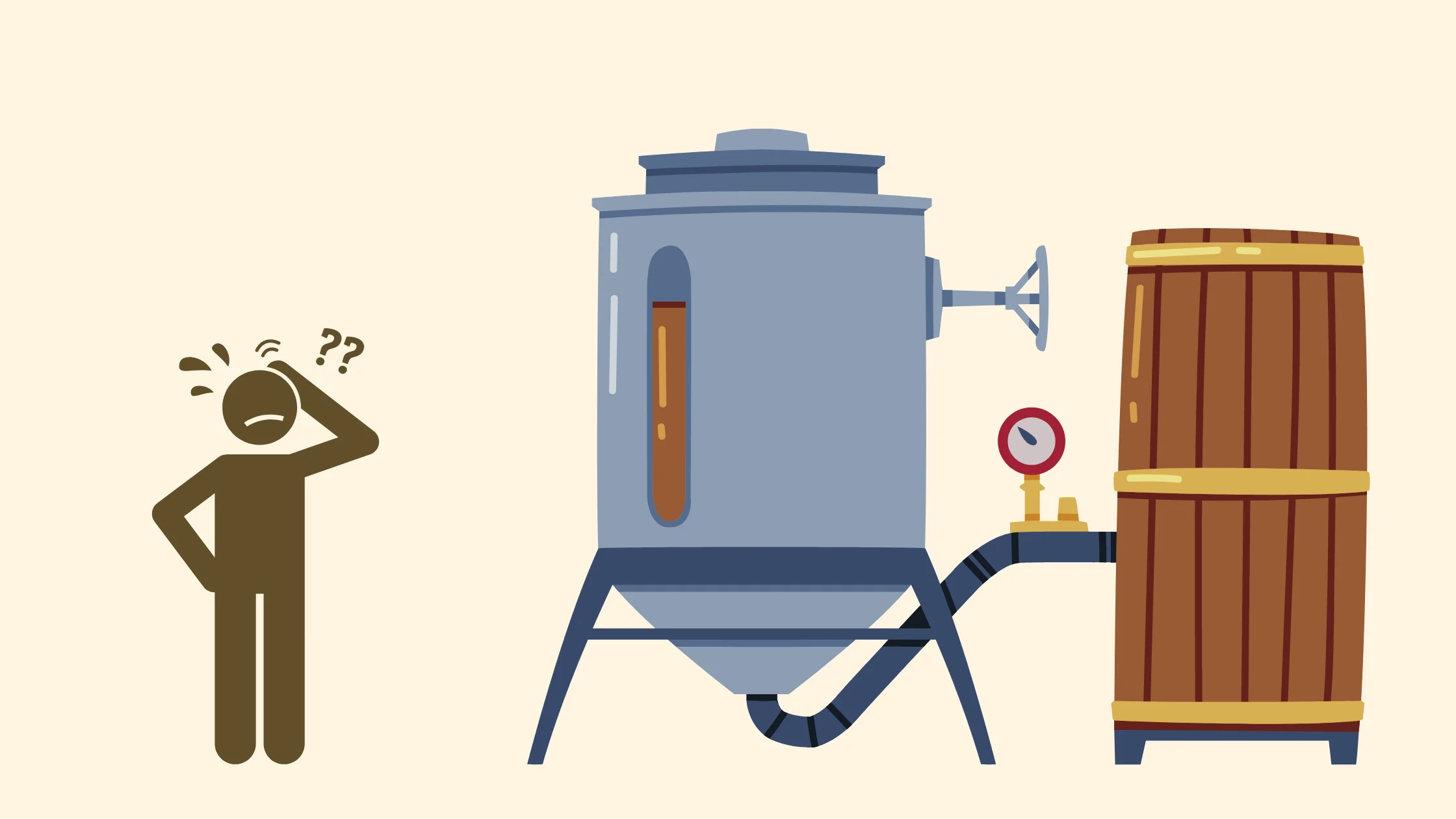Fermentation marks a pivotal moment in whiskey making, a delicate dance where simple sugars are artfully turned into alcohol. The process begins with mashing, where grains are steeped to release their fermentable sugars, and the mash’s enzymatic conversion sets the stage for the next act. The cast of grains—barley, corn, rye, and wheat—each plays a role in the flavor narrative, bringing distinct notes to the fore.
Enter yeast, the unsung hero, meticulously chosen for its ability to not only produce ethanol but also to craft a complex array of flavor compounds. The duration of fermentation, a span that typically stretches over days, is a deliberate choice that influences the final flavor profile. Within this time, a symphony of congeners forms, laying down the foundational aromas and tastes of the whiskey.
As the wash ferments, temperature and pH levels are carefully curated to cultivate optimal yeast performance. The resulting liquid, rich with potential, sets the stage for the transformative art of distillation and aging, where it will develop into the revered spirit known as whiskey. This intricate interplay of science and craft defines the very essence of whiskey, from its most elemental form to the complex libation savored by enthusiasts around the globe.
What is fermentation in whiskey making?
Fermentation in whiskey making is the biochemical process where yeast converts sugars derived from grains into alcohol and other compounds. This crucial step takes place after the mashing process, which breaks down the starches into fermentable sugars. The choice of grain—barley, corn, rye, or wheat—affects the sugar composition and ultimately the flavor profile of the whiskey.
Yeast strains are carefully selected to further influence taste, as they not only produce ethanol but also a range of congeners, which are responsible for adding nuanced aromas and flavors to the spirit. The fermentation period, typically lasting several days, is closely monitored for temperature and pH to ensure the yeast thrives and produces the desired outcome.
This stage sets the foundation for the whiskey’s character before it undergoes distillation and aging, culminating in the rich and complex beverage enjoyed by connoisseurs.
What is fermentation in whiskey making?
Fermentation is a key biochemical transformation in whiskey production where yeast converts fermentable sugars into alcohol and flavor compounds. This process begins post-mashing, where grains like barley, corn, rye, and wheat are broken down to release sugars. The type of grain not only dictates the sugar profile but also the ensuing flavor nuances of the whiskey.
Selecting the right yeast strain is crucial, as it influences the production of ethanol and a spectrum of congeners—the vital elements that impart complex aromas and tastes. The duration of fermentation, usually spanning a few days, is finely tuned, with precise control over temperature and pH levels to foster optimal yeast activity.
The outcome of fermentation is a rich wash that forms the whiskey’s foundational character, subsequently refined through distillation and maturation. This stage is instrumental in shaping the sophisticated flavors and aromas that define the whiskey savored worldwide.
How is fermentation initiated?
Fermentation begins with the mashing process, where the complex starches in grains are broken down into fermentable sugars through enzymatic conversion. This mash—a warm, soupy blend of milled grain and water—creates an ideal environment for yeast to flourish.
The selection of specific yeast strains is critical, as these microorganisms are responsible for converting sugars into ethanol and congeners—the key compounds that contribute to whiskey’s unique flavor profile. By introducing yeast to the mash, the fermentation process is set in motion, a pivotal step in the transformation that culminates in the whiskey’s distinctive character.
Mashing Process
The mashing process begins with steeping milled grains in hot water, which activates the grain’s natural enzymes. These enzymes play a crucial role in breaking down the complex starches into simpler, fermentable sugars. This step not only sets the stage for fermentation but also influences the potential alcohol content and the foundational flavor profile of the whiskey.
Enzymatic Conversion to Fermentable Sugars
Enzymatic conversion is a pivotal chemical reaction within the mashing process. As the temperature rises, enzymes such as amylase catalyze the transformation of starches into sugars that are readily fermentable by yeast. The success of this conversion is paramount, as it determines the efficiency of the fermentation process and the richness of the flavor compounds in the matured whiskey.
What grains are used in whiskey fermentation?
A diverse array of grains are pivotal in whiskey fermentation, each contributing its distinctive flavor characteristics. Barley is the traditional choice for single malt Scotch and Irish whiskeys, known for imparting a rich and robust flavor. Corn, the primary grain in Bourbon, lends a sweet and full-bodied profile that is unmistakably smooth.
For those seeking a whiskey with a spicy kick, rye is the go-to grain, delivering spicy and fruity notes that define rye whiskey. Meanwhile, wheat is appreciated for its gentle and smooth qualities, often used in wheated Bourbons for a milder taste. The selection of grain not only categorizes the whiskey but also forms the essence of its diverse flavor spectrum.
Barley
Barley stands at the forefront of whiskey production, especially for single malt Scotch and Irish whiskeys. This grain is rich in enzymes necessary for the conversion of starches into fermentable sugars, and it imparts a malty flavor that is the hallmark of many classic whiskeys.
Corn
Corn takes center stage in Bourbon production due to its high sugar content, which translates into a higher potential alcohol yield. Its inherent sweetness gives Bourbon a velvety texture and contributes to a full-bodied flavor that is both rich and inviting.
Rye
Rye is the grain of choice for those seeking a whiskey with a spicy edge. It delivers a bold, peppery flavor that distinguishes rye whiskey from its sweeter counterparts, offering a robust and flavorful experience.
Wheat
Wheat is favored for its smoothness and mild character, often used in wheated Bourbons to provide a gentle sweetness. This grain softens the whiskey’s profile, making wheated varieties notably mellow and accessible to a broad audience.
Yeast’s Role in Whiskey Fermentation
Yeast is the driving force behind the fermentation process in whiskey production, a microscopic yet mighty agent that turns sugars into alcohol. The careful selection of yeast strains is a crucial decision, as different strains can produce varying levels of ethanol and a diverse range of congeners—the complex compounds that contribute to the whiskey’s flavor and aroma.
During fermentation, yeast’s role extends beyond alcohol production; it’s instrumental in shaping the whiskey’s distinctive character. The activity of yeast, governed by the fermentation environment’s temperature and pH, is meticulously controlled to cultivate the desired sensory profile. This makes yeast not just a participant, but a defining factor in the art of whiskey making.
Yeast Strains Selection
The selection of yeast strains is a critical juncture in the whiskey-making process. Distillers opt for strains that not only efficiently ferment the mash but also enrich the whiskey with a distinct flavor and aroma profile. This choice is crucial as it determines the array of congeners—the flavor compounds—that will define the whiskey’s character.
Fermentation Initiation
Fermentation is initiated when yeast meets the sugar-laden mash. This is the moment when yeast begins its work, metabolizing sugars to produce ethanol and carbon dioxide. The success of this stage hinges on precise control over the fermentation environment, ensuring optimal yeast performance and a consistent start to the process.
Ethanol and Flavor Compounds Production
During fermentation, yeast not only produces ethanol, the primary alcohol in whiskey, but also a variety of flavor compounds, known as congeners. These include esters, which impart fruity notes, aldehydes, which can add nutty flavors, and higher alcohols that contribute to the whiskey’s body and warmth. The production of these compounds is essential, as they lay the groundwork for the whiskey’s intricate flavor and aroma that will be further refined during the aging process.
Byproducts of Fermentation in Whiskey
During the fermentation of whiskey, yeast’s interaction with sugars creates ethanol, the spirit’s primary alcohol, along with a variety of critical byproducts known as congeners. These compounds, which include esters, aldehydes, and higher alcohols, are integral to the whiskey’s ultimate flavor profile and aroma.
In addition to ethanol, the fermentation process naturally produces carbon dioxide, a byproduct of yeast metabolism. The presence and balance of these congeners are essential, as they contribute to the whiskey’s unique characteristics, from floral and fruity notes to rich and smoky undertones, which are highly valued by whiskey enthusiasts.
Ethanol as the Primary Alcohol
Ethanol is the primary alcohol produced in whiskey fermentation, a direct outcome of yeast metabolizing fermentable sugars. It forms the essence of whiskey, providing not just the spirit’s strength but also its characteristic warmth.
Carbon Dioxide Release
The fermentation process is marked by the release of carbon dioxide, a telltale sign of yeast at work. This effervescence is more than just a byproduct; it’s a key indicator of fermentation’s progress and a sign that the yeast is actively transforming sugars into alcohol.
Congeners for Flavor and Aroma
Alongside ethanol, a variety of congeners are produced, which are responsible for the whiskey’s complex flavor and aroma. These byproducts, including esters and aldehydes, impart a spectrum of sensory notes, from fruity and floral to nutty and caramel, adding remarkable depth to the whiskey’s overall character.
Duration of Whiskey Fermentation
The duration of whiskey fermentation is a critical factor in the production process, typically ranging from 48 hours to over a week. This period is strategically chosen based on the type of yeast strain and the desired flavor complexity. A longer fermentation allows for an enhanced development of congeners, contributing to a richer and more intricate flavor profile.
Key factors such as the mash composition and fermentation temperature influence the length of this phase, ensuring that the yeast efficiently converts all available sugars into alcohol and flavor compounds. The careful calibration of fermentation time is essential, as it directly impacts the quality and character of the final whiskey.
Typical Range of Days
The fermentation process in whiskey making typically spans a typical range of 48 hours to upwards of a week. This duration is carefully selected to allow the yeast to fully metabolize the sugars, balancing the production of ethanol with the development of desirable flavor congeners.
Factors Affecting Duration
Several factors influence the duration of fermentation, key among them being the yeast strain used, which can have varying rates of sugar consumption. The temperature of the fermentation environment also plays a crucial role; warmer temperatures can speed up the process, while cooler ones may slow it down. Additionally, the specific composition of the mash, including the types of grains and their sugar content, can affect how long fermentation takes to complete. Distillers must consider these variables to optimize the process for the best possible whiskey flavor.
Conditions for Optimal Fermentation
Creating the perfect environment for fermentation is key to crafting exceptional whiskey. Controlled temperature is crucial, as it directly influences the yeast’s activity and the spectrum of flavor compounds produced. Distillers aim to maintain a temperature that’s neither too hot, which can produce unwanted flavors, nor too cold, which can slow down fermentation.
Equally important is maintaining the ideal pH level, which ensures the yeast remains healthy and active throughout the process. This balance is vital for a consistent and efficient fermentation, ultimately shaping the whiskey’s final taste and quality. These conditions are carefully monitored and adjusted to provide the optimal setting for the yeast to work its magic.
Controlled Temperature Range
Maintaining a controlled temperature range is critical for the fermentation of whiskey. The precise temperature not only ensures the yeast’s optimal performance but also guards against the formation of off-flavors. Distillers carefully regulate this range to encourage the production of desirable congeners that enhance the whiskey’s flavor profile.
Desired pH Level for Yeast Activity
The pH level of the mash is a key determinant of yeast activity and, consequently, the quality of the whiskey. An optimal pH level is necessary to promote yeast health and efficiency, which in turn supports a robust fermentation process. Monitoring and adjusting the pH level helps maintain an environment conducive to producing a superior whiskey.
Fermentation’s Impact on Whiskey Flavor
Fermentation significantly shapes the flavor profile of whiskey. The selection of a yeast strain is a strategic choice that influences the array of flavors and aromas in the final product. Congeners, which are vital byproducts of fermentation, contribute complex notes ranging from fruity and floral to spicy and smoky.
The duration of fermentation is another key factor; a longer fermentation allows for a richer development of flavor complexities. Collectively, these elements underscore the importance of the fermentation process in crafting the unique character and taste of whiskey.
Influence of Yeast Strain
The yeast strain plays a pivotal role in shaping the whiskey’s flavor. Each strain imparts a unique set of enzymatic activities, leading to the formation of distinct congeners. These compounds are essential for the complexity of the whiskey’s aroma and taste, making the choice of yeast a critical step in the distillation process.
Effect of Fermentation Duration
The duration of fermentation directly impacts the development of the whiskey’s flavor. An extended fermentation period allows for a more intricate congener profile, resulting in a whiskey with a richer and more layered character. Conversely, a shorter fermentation may produce a whiskey with a simpler, more straightforward flavor, demonstrating the importance of carefully timing this phase.
Post-fermentation Steps in Whiskey Production
Post-fermentation, whiskey production advances through crucial stages that shape the spirit’s final character. The distillation process begins with the fermented wash being heated, causing alcohol to vaporize. These vapors are then condensed, resulting in a more refined and concentrated spirit.
Next, the whiskey matures in barrels, a phase where it develops its distinctive color and complexity. This aging process is pivotal, as the interaction between the whiskey and the wood infuses it with a range of subtle flavors and aromas. Each of these post-fermentation steps is executed with precision, playing an indispensable role in crafting the whiskey’s ultimate profile.
Distillation Process
The distillation process marks a pivotal phase in whiskey making, where the fermented wash is heated, prompting alcohol to vaporize. This vapor, carrying a spectrum of flavors, is then cooled and condensed back into liquid form, creating a potent distillate rich in ethanol and flavor compounds.
Aging in Barrels
The art of aging in barrels significantly shapes the whiskey’s final character. Whiskey is stored in barrels, typically made of oak, which contribute to its color and complexity. During this period, the spirit absorbs compounds from the wood, gaining flavors like vanilla, toffee, and spice. The duration of barrel aging is a key factor, with longer periods generally resulting in a whiskey with greater depth and a more nuanced flavor profile.





